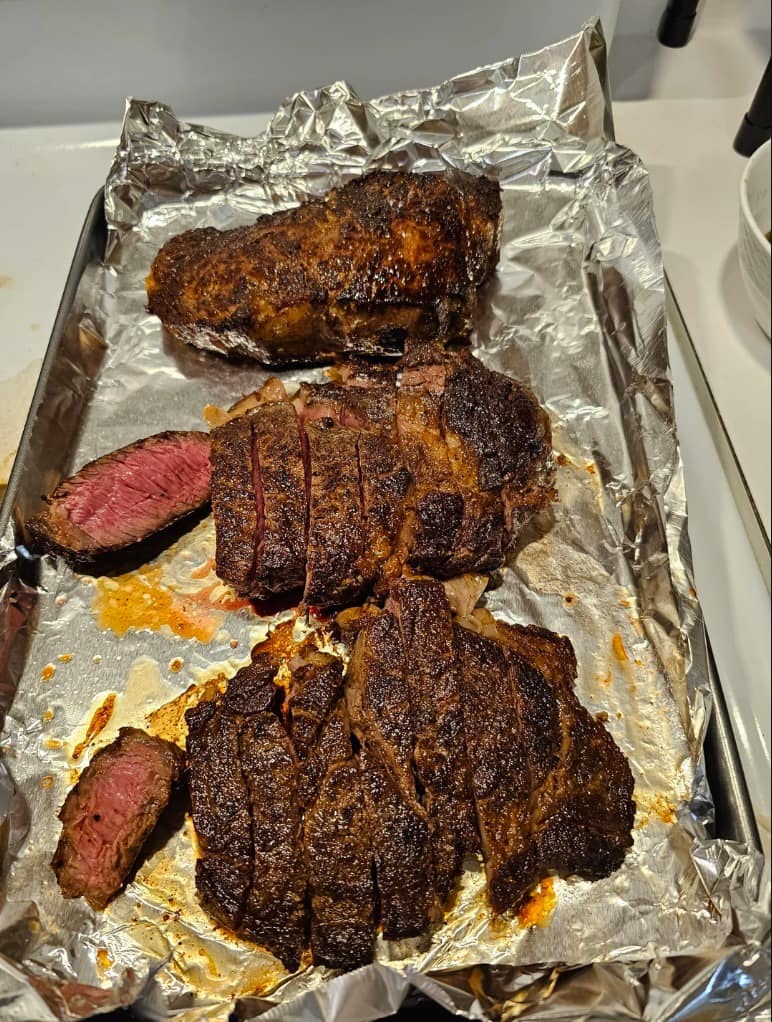ADVERTISEMENT
Instructions:
1. Bring the Steaks to Room Temperature
- The key to a perfectly cooked ribeye steak starts before it even hits the pan or grill. Let the steaks rest at room temperature for about 30 minutes before cooking. This ensures even cooking throughout and helps prevent the steak from being cold in the center when cooked.
2. Season the Steaks Generously
- Pat the steaks dry with a paper towel to remove any excess moisture. This helps achieve a nice sear.
- Season both sides of the ribeye steaks with a generous amount of salt and freshly ground black pepper. Don’t be shy with the seasoning—ribeye steaks benefit from bold flavors, and the seasoning will help enhance the steak’s natural richness.
3. Preheat the Pan or Grill
- Whether you’re cooking the steaks on a cast iron skillet or a grill, make sure to preheat it to medium-high heat. If you’re using a pan, heat it for about 5 minutes to get it nice and hot. The same goes for the grill—preheat the grates for a few minutes before cooking.
4. Sear the Steak
- Heat the olive oil or butter in the hot skillet or grill. Once it’s shimmering or melted, carefully add the ribeye steaks.
- Sear the steaks on one side for 4-5 minutes without moving them, to create a delicious caramelized crust. Resist the urge to flip them too early!
- Flip the steaks and sear the other side for another 4-5 minutes. If you’re using a grill, you can also cover the grill to help the steaks cook evenly on all sides.
5. Add Flavor Enhancers (Optional)
- During the last minute of cooking, add 2-3 crushed garlic cloves and a sprig of rosemary or thyme to the pan. You can also add an extra tablespoon of butter at this stage for a rich, buttery finish.
- Tilt the pan slightly and use a spoon to baste the steaks with the melted butter and aromatics for added flavor.
6. Check for Desired Doneness
- The cooking time can vary depending on your desired level of doneness. For a medium-rare ribeye, aim for an internal temperature of about 130-135°F (54-57°C).
- Here’s a quick guide to steak doneness and their internal temperatures:
- Rare: 120-125°F (49-52°C)
- Medium-rare: 130-135°F (54-57°C)
- Medium: 140-145°F (60-63°C)
- Medium-well: 150-155°F (66-68°C)
- Well-done: 160°F (71°C) and above
- Use a meat thermometer to check the steak’s internal temperature for accuracy.
7. Rest the Steak
- Once the steaks are cooked to your desired doneness, remove them from the pan or grill and place them on a cutting board or plate. Cover loosely with foil and let them rest for 5-10 minutes. Resting allows the juices to redistribute, resulting in a more flavorful and tender steak.
8. Slice and Serve
- After resting, slice the ribeye steak against the grain for the best texture. You can serve the steak whole or slice it into strips, depending on your preference.
- Garnish with fresh rosemary or thyme and serve with your favorite sides, such as mashed potatoes, roasted vegetables, or a simple salad.
Why Ribeye Steak Is the Best Choice:
- Rich Marbling: Ribeye steaks are known for their abundant marbling—those little streaks of fat within the meat—which melt during cooking, creating a juicy, tender, and flavorful steak.
- Tenderness: Despite being a cut from the rib section of the cow, the ribeye is one of the most tender cuts available. The marbling helps the steak stay juicy and tender, even if cooked to a medium-well doneness.
- Flavor: Ribeye steaks are full of flavor, thanks to the fat content, which adds a rich, beefy taste. This cut is perfect for those who enjoy a juicy and flavorful steak.
Tips for the Perfect Ribeye Steak:
- Avoid Overcrowding the Pan: If you’re cooking multiple steaks, make sure not to overcrowd the pan. This can prevent the steaks from getting a nice sear. Cook in batches if needed.
- Use a Cast Iron Skillet: A cast iron skillet retains heat well, making it perfect for getting a great sear. If you don’t have one, any heavy-bottomed pan will work, but cast iron is ideal.
- Let the Steak Rest: Don’t skip the resting step! It’s crucial for a tender steak, as it allows the juices to redistribute and prevents the steak from becoming dry.
- Experiment with Seasonings: While salt and pepper are classic, you can customize the seasoning by adding garlic powder, onion powder, or even a dash of paprika for extra flavor.
- Grilling Option: If you prefer grilling, simply cook the ribeye over direct medium-high heat, following the same searing and resting process.
Conclusion:
Cooking the perfect ribeye steak at home doesn’t require any special skills or fancy equipment—just good-quality beef, a little seasoning, and some basic cooking techniques. With this simple homemade recipe, you can create a steak that’s juicy, flavorful, and cooked to perfection every time. Whether you’re celebrating a special occasion or simply craving a hearty meal, this ribeye steak recipe is sure to impress and satisfy.
So fire up the grill or heat up the skillet—your perfect ribeye steak awaits!
ADVERTISEMENT
